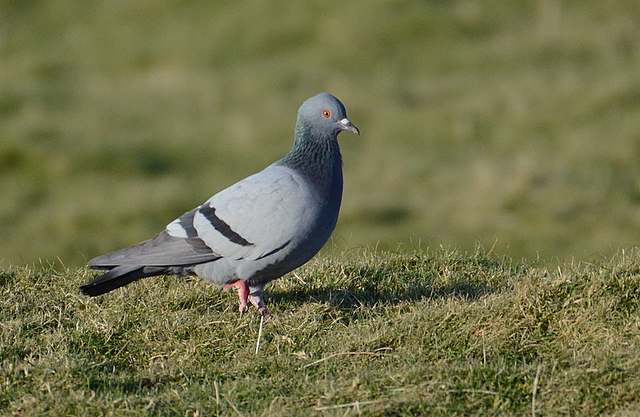For most of us, when we see a bird belonging to the species Columba livia, we have seen a ‘feral pigeon’. This bird originates from escaped domestic pigeons and is one of the most abundant birds in the world. It can be easy to forget that the pre-domestication state of the species is the wild Rock Dove.
Some of these birds persist along the Atlantic coasts of Britain and Ireland. Since 2019, genomic sampling of wild Rock Doves from various locations around Britain and Ireland has aimed to explore the extent of hybridisation with feral pigeons. Across much of Europe, the wild Rock Dove is now extinct following this ‘genomic mixing’, so research focusing on the process is very important.

More than 300 wild Rock Doves have been colour-ringed as part of the project so far (Joe Graham).
A recent paper that resulted from these efforts, which were co-ordinated from the University of Oxford, highlighted populations in the Outer Hebrides, and particularly the Uists, as being the least exposed to gene flow from feral pigeons. Wild Rock Doves also persist in western Ireland, the Inner Hebrides, Arran, the Northern Isles and the north coast of Scotland. Their genetic status in the Mediterranean and Faroe Islands, and indeed outside of Europe, needs further research.
The basic biology of the wild Rock Dove is unknown, contrasting with their well-studied feral and domestic cousins. Because of this, over the past couple of years, we have set up three new colour-ringing studies to explore the survival and movement ecology of the Rock Doves of the Outer Hebrides, Skye and Cape Clear Island. All three of these regions are popular with birders, but are perhaps more famous for migrants or arguably more charismatic birds such as raptors, Corncrakes and wading birds. We would therefore like to appeal for local and visiting birders to keep an eye out for colour-ringed Rock Doves.
All birds are ringed with metal rings on the right leg and colour rings (with a two-alpha or two-alpha-numeric code) on the left leg. The birds of Cape Clear Island, Skye and the Outer Hebrides are fitted with dark blue, yellow and dark green colour rings respectively. Wild Rock Doves are shy and best viewed at a distance or from inside a car, and can be seen around cliffs, caves, ruined buildings, or feeding on agricultural land.
Sightings of colour-ringed Rock Doves will help us to better understand juvenile dispersal, survival rates and foraging movements, all of which are fundamental in enabling us to infer patterns of gene flow with feral pigeons. We have so far collectively colour-ringed more than 300 birds and this number will continue to increase. If you have sightings to report, or questions about colour ringing, please contact the relevant project lead:
- Will Smith – Outer Hebrides (Twitter: @WJSmith97, email: willjsmith9[at]gmail.com
- Jonathan Jones – Skye (Twitter: @JJskyebirding, email: jjonskye[at]yahoo.co.uk)
- Sam Bayley – Cape Clear (Twitter: @SamBayley2, email: sam.bayley[at]btinternet.co.uk)
This project has been supported by the Edward Grey Institute of Field Ornithology, Genetics Society, John Muir Trust, Houghton Trust, BirdWatch Ireland and Mary Cadogan.


